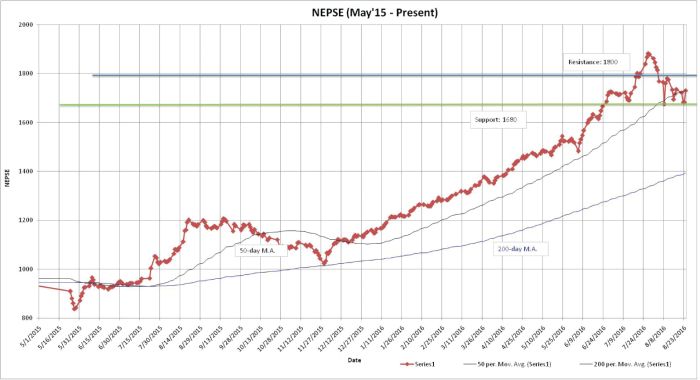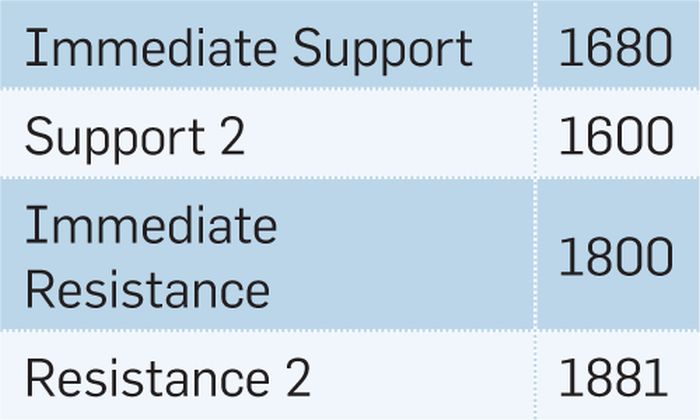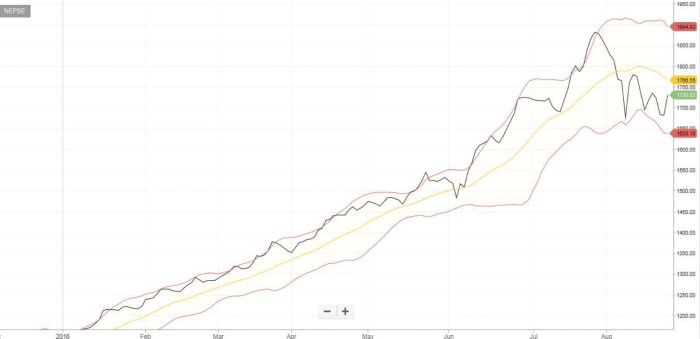Notice (8): Trying to access array offset on value of type null [APP/View/MagazineArticles/view.ctp, line 54]Code Context $user = $this->Session->read('Auth.User');
//find the group of logged user
$groupId = $user['Group']['id'];
$viewFile = '/var/www/html/newbusinessage.com/app/View/MagazineArticles/view.ctp'
$dataForView = array(
'magazineArticle' => array(
'MagazineArticle' => array(
'id' => '1567',
'magazine_issue_id' => '965',
'magazine_category_id' => '63',
'title' => 'Monthly Technical Analysis of Nepse (31 July to 25 August 2016)',
'image' => null,
'short_content' => 'The benchmark index went through high volatility last month. The index lost a staggering 147.31 points (or down -7.72%) to close at 1730.62. Nepse lost 202.02 points during the first half of the month. The index hit a negative, as well as positive circuit break during the middle of the month, as nervousness became apparent in the market. ',
'content' => '<p style="text-align:justify"><span style="font-size:18px"><strong>A Volatile Month</strong></span></p>
<p style="text-align:justify"><span style="font-size:18px"><strong><img alt="" src="/userfiles/images/s1%288%29.jpg" style="height:380px; width:700px" /></strong></span></p>
<p style="text-align:justify"><img alt="" src="/userfiles/images/s%283%29.jpg" style="height:378px; width:700px" /></p>
<p style="text-align:justify"><span style="font-size:16px"><strong>Trend Analysis</strong></span><br />
The benchmark index went through high volatility last month. The index lost a staggering 147.31 points (or down -7.72%) to close at 1730.62. Nepse lost 202.02 points during the first half of the month. The index hit a negative, as well as positive circuit break during the middle of the month, as nervousness became apparent in the market. The index moved below the 50-day moving average towards the end of the month, which showed a presence of bearish behavior in the market. However, the index continues to move well above the 200-day moving average, indicating that the long term market outlook looks good.</p>
<p style="text-align:justify"><span style="font-size:16px"><strong>Resistance and Support</strong></span></p>
<p style="text-align:justify"><img alt="" src="/userfiles/images/s0.jpg" style="height:420px; width:700px" /></p>
<p style="text-align:justify">The benchmark indexmoved below the immediate support level of 1723 during the middle of the month. However, towards the end of the month, the index climbed back up and ended at 1730.62. The index experienced high volatility throughout the month. The new support and resistance level now stands at 1680 and 1800 respectively. Although the market was in bearish mode for most of last month, it picked up bullish sentiment at the end of the month. Hence the index could climb back up and surpass the resistance level of 1800 in the coming weeks. </p>
<p style="text-align:justify"><br />
<img alt="" src="/userfiles/images/s3%284%29.jpg" style="height:135px; width:700px" /></p>
<p style="text-align:justify"><span style="font-size:16px"><strong>Nepse Trend Indicator</strong></span><br />
<strong>a. MACD</strong><br />
The MACD is a momentum oscillator formed by using two different types of moving averages, which provides specific buying or selling signals. When a MACD line crosses above the signal line, it is considered to be a positive sign and indicates a time to buy, and vice-versa. </p>
<p style="text-align:justify">The MACD and the signal line, at the beginning of the month,stood at 61.35 and 53.89 respectively. However, the macd line moved below the signal line soon after, indicating a bearish signal. Furthermore, the macd has entered the negative territory as well, signaling bearish signs. Towards the end of the month, the macd and the signal line closed at -11.15 and 0.06 respectively. </p>
<p style="text-align:justify"><span style="font-size:14px"><strong>b. RSI</strong></span><br />
RSI is a form of leading indicator that is believed to be most effective during periods of sideways movement. Such indicators may create numerous buy and sell signals that are useful when the market is not clearly trending upwards or downwards. </p>
<p style="text-align:justify">The RSI, at the beginning of last month, stood at 77.40 level, indicating a high buying pressure in the market. However, in the course of the month, the RSI took a downturn and hovered around 40’s zone for most of the month. Such levels indicate a decrease in the buying pressure in the market. By the end of the month, the RSI lost 28.73 points to close at 48.67 level.</p>
<p style="text-align:justify"><img alt="" src="/userfiles/images/s4%286%29.jpg" style="height:73px; width:700px" /></p>
<p style="text-align:justify"><strong>c. Bollinger Bands</strong><br />
The Bollinger Band is a technical indicator that consists of a moving average (21-day) along with two trading bands above (upper band) and below it (lower band). The bands are an indication of volatility, which are represented by calculating standard deviation. </p>
<p style="text-align:justify">The benchmark indexfell down towards the lower bollinger band during the first half of the month. For the second half of the month, Nepse hovered between the lower and middle bands, signifying a decrease in buying pressure in the market. The distance between the upper and lower bands has increased throughout the month, indicating presence of high volatility in the market.</p>
<p style="text-align:justify"><img alt="" src="/userfiles/images/s5%283%29.jpg" style="height:339px; width:700px" /></p>
<p style="text-align:justify"><span style="font-size:16px"><strong>Overview</strong></span><br />
The benchmark index lost 147.31 points (or down 7.72%) to close at 1730.62. The index is hovering around the 50 day moving average, which shows short term nervousness in the market. However, the index is well above the 200 day moving average, indicating the long term market outlook looks good. The technical indicators show bearish presence in the market. The macd line is in the negative territory, and moving below the signal line. The RSI has come out of the over-bought zone and hovering around 48.67 level. The bollinger bandsalso show a decrease in buying pressure and increase in market volatility. The new support and resistance level stands at 1680 and 1800 respectively. </p>
',
'status' => true,
'publish_date' => '0000-00-00',
'created' => '2016-09-19 12:35:40',
'modified' => '2016-09-19 12:48:55',
'keywords' => '',
'description' => '',
'sortorder' => '1526',
'feature_article' => true,
'user_id' => '11',
'image1' => null,
'image2' => null,
'image3' => null,
'image4' => null
),
'MagazineIssue' => array(
'id' => '965',
'image' => '20160916030425_cover.JPG',
'sortorder' => '1514',
'published' => true,
'created' => '2016-09-16 15:04:25',
'modified' => '2016-09-16 15:10:07',
'title' => 'September 2016',
'publish_date' => '2016-09-01',
'parent_id' => '0',
'homepage' => true,
'user_id' => '11'
),
'MagazineCategory' => array(
'id' => '63',
'title' => 'Stock Taking',
'sortorder' => '516',
'status' => true,
'created' => '0000-00-00 00:00:00',
'homepage' => true,
'modified' => '2013-04-01 00:00:00'
),
'User' => array(
'password' => '*****',
'id' => '11',
'user_detail_id' => '0',
'group_id' => '24',
'username' => 'nsingha@abhiyan.com.np',
'name' => '',
'email' => 'nsingha@abhiyan.com.np',
'address' => '',
'gender' => '',
'access' => '1',
'phone' => '',
'access_type' => '0',
'activated' => false,
'sortorder' => '0',
'published' => '0',
'created' => '2015-04-08 13:22:59',
'last_login' => '2023-04-16 09:29:47',
'ip' => '172.69.77.43'
),
'MagazineArticleComment' => array(),
'MagazineView' => array(
(int) 0 => array(
[maximum depth reached]
)
)
),
'current_user' => null,
'logged_in' => false
)
$magazineArticle = array(
'MagazineArticle' => array(
'id' => '1567',
'magazine_issue_id' => '965',
'magazine_category_id' => '63',
'title' => 'Monthly Technical Analysis of Nepse (31 July to 25 August 2016)',
'image' => null,
'short_content' => 'The benchmark index went through high volatility last month. The index lost a staggering 147.31 points (or down -7.72%) to close at 1730.62. Nepse lost 202.02 points during the first half of the month. The index hit a negative, as well as positive circuit break during the middle of the month, as nervousness became apparent in the market. ',
'content' => '<p style="text-align:justify"><span style="font-size:18px"><strong>A Volatile Month</strong></span></p>
<p style="text-align:justify"><span style="font-size:18px"><strong><img alt="" src="/userfiles/images/s1%288%29.jpg" style="height:380px; width:700px" /></strong></span></p>
<p style="text-align:justify"><img alt="" src="/userfiles/images/s%283%29.jpg" style="height:378px; width:700px" /></p>
<p style="text-align:justify"><span style="font-size:16px"><strong>Trend Analysis</strong></span><br />
The benchmark index went through high volatility last month. The index lost a staggering 147.31 points (or down -7.72%) to close at 1730.62. Nepse lost 202.02 points during the first half of the month. The index hit a negative, as well as positive circuit break during the middle of the month, as nervousness became apparent in the market. The index moved below the 50-day moving average towards the end of the month, which showed a presence of bearish behavior in the market. However, the index continues to move well above the 200-day moving average, indicating that the long term market outlook looks good.</p>
<p style="text-align:justify"><span style="font-size:16px"><strong>Resistance and Support</strong></span></p>
<p style="text-align:justify"><img alt="" src="/userfiles/images/s0.jpg" style="height:420px; width:700px" /></p>
<p style="text-align:justify">The benchmark indexmoved below the immediate support level of 1723 during the middle of the month. However, towards the end of the month, the index climbed back up and ended at 1730.62. The index experienced high volatility throughout the month. The new support and resistance level now stands at 1680 and 1800 respectively. Although the market was in bearish mode for most of last month, it picked up bullish sentiment at the end of the month. Hence the index could climb back up and surpass the resistance level of 1800 in the coming weeks. </p>
<p style="text-align:justify"><br />
<img alt="" src="/userfiles/images/s3%284%29.jpg" style="height:135px; width:700px" /></p>
<p style="text-align:justify"><span style="font-size:16px"><strong>Nepse Trend Indicator</strong></span><br />
<strong>a. MACD</strong><br />
The MACD is a momentum oscillator formed by using two different types of moving averages, which provides specific buying or selling signals. When a MACD line crosses above the signal line, it is considered to be a positive sign and indicates a time to buy, and vice-versa. </p>
<p style="text-align:justify">The MACD and the signal line, at the beginning of the month,stood at 61.35 and 53.89 respectively. However, the macd line moved below the signal line soon after, indicating a bearish signal. Furthermore, the macd has entered the negative territory as well, signaling bearish signs. Towards the end of the month, the macd and the signal line closed at -11.15 and 0.06 respectively. </p>
<p style="text-align:justify"><span style="font-size:14px"><strong>b. RSI</strong></span><br />
RSI is a form of leading indicator that is believed to be most effective during periods of sideways movement. Such indicators may create numerous buy and sell signals that are useful when the market is not clearly trending upwards or downwards. </p>
<p style="text-align:justify">The RSI, at the beginning of last month, stood at 77.40 level, indicating a high buying pressure in the market. However, in the course of the month, the RSI took a downturn and hovered around 40’s zone for most of the month. Such levels indicate a decrease in the buying pressure in the market. By the end of the month, the RSI lost 28.73 points to close at 48.67 level.</p>
<p style="text-align:justify"><img alt="" src="/userfiles/images/s4%286%29.jpg" style="height:73px; width:700px" /></p>
<p style="text-align:justify"><strong>c. Bollinger Bands</strong><br />
The Bollinger Band is a technical indicator that consists of a moving average (21-day) along with two trading bands above (upper band) and below it (lower band). The bands are an indication of volatility, which are represented by calculating standard deviation. </p>
<p style="text-align:justify">The benchmark indexfell down towards the lower bollinger band during the first half of the month. For the second half of the month, Nepse hovered between the lower and middle bands, signifying a decrease in buying pressure in the market. The distance between the upper and lower bands has increased throughout the month, indicating presence of high volatility in the market.</p>
<p style="text-align:justify"><img alt="" src="/userfiles/images/s5%283%29.jpg" style="height:339px; width:700px" /></p>
<p style="text-align:justify"><span style="font-size:16px"><strong>Overview</strong></span><br />
The benchmark index lost 147.31 points (or down 7.72%) to close at 1730.62. The index is hovering around the 50 day moving average, which shows short term nervousness in the market. However, the index is well above the 200 day moving average, indicating the long term market outlook looks good. The technical indicators show bearish presence in the market. The macd line is in the negative territory, and moving below the signal line. The RSI has come out of the over-bought zone and hovering around 48.67 level. The bollinger bandsalso show a decrease in buying pressure and increase in market volatility. The new support and resistance level stands at 1680 and 1800 respectively. </p>
',
'status' => true,
'publish_date' => '0000-00-00',
'created' => '2016-09-19 12:35:40',
'modified' => '2016-09-19 12:48:55',
'keywords' => '',
'description' => '',
'sortorder' => '1526',
'feature_article' => true,
'user_id' => '11',
'image1' => null,
'image2' => null,
'image3' => null,
'image4' => null
),
'MagazineIssue' => array(
'id' => '965',
'image' => '20160916030425_cover.JPG',
'sortorder' => '1514',
'published' => true,
'created' => '2016-09-16 15:04:25',
'modified' => '2016-09-16 15:10:07',
'title' => 'September 2016',
'publish_date' => '2016-09-01',
'parent_id' => '0',
'homepage' => true,
'user_id' => '11'
),
'MagazineCategory' => array(
'id' => '63',
'title' => 'Stock Taking',
'sortorder' => '516',
'status' => true,
'created' => '0000-00-00 00:00:00',
'homepage' => true,
'modified' => '2013-04-01 00:00:00'
),
'User' => array(
'password' => '*****',
'id' => '11',
'user_detail_id' => '0',
'group_id' => '24',
'username' => 'nsingha@abhiyan.com.np',
'name' => '',
'email' => 'nsingha@abhiyan.com.np',
'address' => '',
'gender' => '',
'access' => '1',
'phone' => '',
'access_type' => '0',
'activated' => false,
'sortorder' => '0',
'published' => '0',
'created' => '2015-04-08 13:22:59',
'last_login' => '2023-04-16 09:29:47',
'ip' => '172.69.77.43'
),
'MagazineArticleComment' => array(),
'MagazineView' => array(
(int) 0 => array(
'magazine_article_id' => '1567',
'hit' => '4257'
)
)
)
$current_user = null
$logged_in = false
$user = null
include - APP/View/MagazineArticles/view.ctp, line 54
View::_evaluate() - CORE/Cake/View/View.php, line 971
View::_render() - CORE/Cake/View/View.php, line 933
View::render() - CORE/Cake/View/View.php, line 473
Controller::render() - CORE/Cake/Controller/Controller.php, line 968
Dispatcher::_invoke() - CORE/Cake/Routing/Dispatcher.php, line 200
Dispatcher::dispatch() - CORE/Cake/Routing/Dispatcher.php, line 167
[main] - APP/webroot/index.php, line 117
Notice (8): Trying to access array offset on value of type null [APP/View/MagazineArticles/view.ctp, line 54]Code Context $user = $this->Session->read('Auth.User');
//find the group of logged user
$groupId = $user['Group']['id'];
$viewFile = '/var/www/html/newbusinessage.com/app/View/MagazineArticles/view.ctp'
$dataForView = array(
'magazineArticle' => array(
'MagazineArticle' => array(
'id' => '1567',
'magazine_issue_id' => '965',
'magazine_category_id' => '63',
'title' => 'Monthly Technical Analysis of Nepse (31 July to 25 August 2016)',
'image' => null,
'short_content' => 'The benchmark index went through high volatility last month. The index lost a staggering 147.31 points (or down -7.72%) to close at 1730.62. Nepse lost 202.02 points during the first half of the month. The index hit a negative, as well as positive circuit break during the middle of the month, as nervousness became apparent in the market. ',
'content' => '<p style="text-align:justify"><span style="font-size:18px"><strong>A Volatile Month</strong></span></p>
<p style="text-align:justify"><span style="font-size:18px"><strong><img alt="" src="/userfiles/images/s1%288%29.jpg" style="height:380px; width:700px" /></strong></span></p>
<p style="text-align:justify"><img alt="" src="/userfiles/images/s%283%29.jpg" style="height:378px; width:700px" /></p>
<p style="text-align:justify"><span style="font-size:16px"><strong>Trend Analysis</strong></span><br />
The benchmark index went through high volatility last month. The index lost a staggering 147.31 points (or down -7.72%) to close at 1730.62. Nepse lost 202.02 points during the first half of the month. The index hit a negative, as well as positive circuit break during the middle of the month, as nervousness became apparent in the market. The index moved below the 50-day moving average towards the end of the month, which showed a presence of bearish behavior in the market. However, the index continues to move well above the 200-day moving average, indicating that the long term market outlook looks good.</p>
<p style="text-align:justify"><span style="font-size:16px"><strong>Resistance and Support</strong></span></p>
<p style="text-align:justify"><img alt="" src="/userfiles/images/s0.jpg" style="height:420px; width:700px" /></p>
<p style="text-align:justify">The benchmark indexmoved below the immediate support level of 1723 during the middle of the month. However, towards the end of the month, the index climbed back up and ended at 1730.62. The index experienced high volatility throughout the month. The new support and resistance level now stands at 1680 and 1800 respectively. Although the market was in bearish mode for most of last month, it picked up bullish sentiment at the end of the month. Hence the index could climb back up and surpass the resistance level of 1800 in the coming weeks. </p>
<p style="text-align:justify"><br />
<img alt="" src="/userfiles/images/s3%284%29.jpg" style="height:135px; width:700px" /></p>
<p style="text-align:justify"><span style="font-size:16px"><strong>Nepse Trend Indicator</strong></span><br />
<strong>a. MACD</strong><br />
The MACD is a momentum oscillator formed by using two different types of moving averages, which provides specific buying or selling signals. When a MACD line crosses above the signal line, it is considered to be a positive sign and indicates a time to buy, and vice-versa. </p>
<p style="text-align:justify">The MACD and the signal line, at the beginning of the month,stood at 61.35 and 53.89 respectively. However, the macd line moved below the signal line soon after, indicating a bearish signal. Furthermore, the macd has entered the negative territory as well, signaling bearish signs. Towards the end of the month, the macd and the signal line closed at -11.15 and 0.06 respectively. </p>
<p style="text-align:justify"><span style="font-size:14px"><strong>b. RSI</strong></span><br />
RSI is a form of leading indicator that is believed to be most effective during periods of sideways movement. Such indicators may create numerous buy and sell signals that are useful when the market is not clearly trending upwards or downwards. </p>
<p style="text-align:justify">The RSI, at the beginning of last month, stood at 77.40 level, indicating a high buying pressure in the market. However, in the course of the month, the RSI took a downturn and hovered around 40’s zone for most of the month. Such levels indicate a decrease in the buying pressure in the market. By the end of the month, the RSI lost 28.73 points to close at 48.67 level.</p>
<p style="text-align:justify"><img alt="" src="/userfiles/images/s4%286%29.jpg" style="height:73px; width:700px" /></p>
<p style="text-align:justify"><strong>c. Bollinger Bands</strong><br />
The Bollinger Band is a technical indicator that consists of a moving average (21-day) along with two trading bands above (upper band) and below it (lower band). The bands are an indication of volatility, which are represented by calculating standard deviation. </p>
<p style="text-align:justify">The benchmark indexfell down towards the lower bollinger band during the first half of the month. For the second half of the month, Nepse hovered between the lower and middle bands, signifying a decrease in buying pressure in the market. The distance between the upper and lower bands has increased throughout the month, indicating presence of high volatility in the market.</p>
<p style="text-align:justify"><img alt="" src="/userfiles/images/s5%283%29.jpg" style="height:339px; width:700px" /></p>
<p style="text-align:justify"><span style="font-size:16px"><strong>Overview</strong></span><br />
The benchmark index lost 147.31 points (or down 7.72%) to close at 1730.62. The index is hovering around the 50 day moving average, which shows short term nervousness in the market. However, the index is well above the 200 day moving average, indicating the long term market outlook looks good. The technical indicators show bearish presence in the market. The macd line is in the negative territory, and moving below the signal line. The RSI has come out of the over-bought zone and hovering around 48.67 level. The bollinger bandsalso show a decrease in buying pressure and increase in market volatility. The new support and resistance level stands at 1680 and 1800 respectively. </p>
',
'status' => true,
'publish_date' => '0000-00-00',
'created' => '2016-09-19 12:35:40',
'modified' => '2016-09-19 12:48:55',
'keywords' => '',
'description' => '',
'sortorder' => '1526',
'feature_article' => true,
'user_id' => '11',
'image1' => null,
'image2' => null,
'image3' => null,
'image4' => null
),
'MagazineIssue' => array(
'id' => '965',
'image' => '20160916030425_cover.JPG',
'sortorder' => '1514',
'published' => true,
'created' => '2016-09-16 15:04:25',
'modified' => '2016-09-16 15:10:07',
'title' => 'September 2016',
'publish_date' => '2016-09-01',
'parent_id' => '0',
'homepage' => true,
'user_id' => '11'
),
'MagazineCategory' => array(
'id' => '63',
'title' => 'Stock Taking',
'sortorder' => '516',
'status' => true,
'created' => '0000-00-00 00:00:00',
'homepage' => true,
'modified' => '2013-04-01 00:00:00'
),
'User' => array(
'password' => '*****',
'id' => '11',
'user_detail_id' => '0',
'group_id' => '24',
'username' => 'nsingha@abhiyan.com.np',
'name' => '',
'email' => 'nsingha@abhiyan.com.np',
'address' => '',
'gender' => '',
'access' => '1',
'phone' => '',
'access_type' => '0',
'activated' => false,
'sortorder' => '0',
'published' => '0',
'created' => '2015-04-08 13:22:59',
'last_login' => '2023-04-16 09:29:47',
'ip' => '172.69.77.43'
),
'MagazineArticleComment' => array(),
'MagazineView' => array(
(int) 0 => array(
[maximum depth reached]
)
)
),
'current_user' => null,
'logged_in' => false
)
$magazineArticle = array(
'MagazineArticle' => array(
'id' => '1567',
'magazine_issue_id' => '965',
'magazine_category_id' => '63',
'title' => 'Monthly Technical Analysis of Nepse (31 July to 25 August 2016)',
'image' => null,
'short_content' => 'The benchmark index went through high volatility last month. The index lost a staggering 147.31 points (or down -7.72%) to close at 1730.62. Nepse lost 202.02 points during the first half of the month. The index hit a negative, as well as positive circuit break during the middle of the month, as nervousness became apparent in the market. ',
'content' => '<p style="text-align:justify"><span style="font-size:18px"><strong>A Volatile Month</strong></span></p>
<p style="text-align:justify"><span style="font-size:18px"><strong><img alt="" src="/userfiles/images/s1%288%29.jpg" style="height:380px; width:700px" /></strong></span></p>
<p style="text-align:justify"><img alt="" src="/userfiles/images/s%283%29.jpg" style="height:378px; width:700px" /></p>
<p style="text-align:justify"><span style="font-size:16px"><strong>Trend Analysis</strong></span><br />
The benchmark index went through high volatility last month. The index lost a staggering 147.31 points (or down -7.72%) to close at 1730.62. Nepse lost 202.02 points during the first half of the month. The index hit a negative, as well as positive circuit break during the middle of the month, as nervousness became apparent in the market. The index moved below the 50-day moving average towards the end of the month, which showed a presence of bearish behavior in the market. However, the index continues to move well above the 200-day moving average, indicating that the long term market outlook looks good.</p>
<p style="text-align:justify"><span style="font-size:16px"><strong>Resistance and Support</strong></span></p>
<p style="text-align:justify"><img alt="" src="/userfiles/images/s0.jpg" style="height:420px; width:700px" /></p>
<p style="text-align:justify">The benchmark indexmoved below the immediate support level of 1723 during the middle of the month. However, towards the end of the month, the index climbed back up and ended at 1730.62. The index experienced high volatility throughout the month. The new support and resistance level now stands at 1680 and 1800 respectively. Although the market was in bearish mode for most of last month, it picked up bullish sentiment at the end of the month. Hence the index could climb back up and surpass the resistance level of 1800 in the coming weeks. </p>
<p style="text-align:justify"><br />
<img alt="" src="/userfiles/images/s3%284%29.jpg" style="height:135px; width:700px" /></p>
<p style="text-align:justify"><span style="font-size:16px"><strong>Nepse Trend Indicator</strong></span><br />
<strong>a. MACD</strong><br />
The MACD is a momentum oscillator formed by using two different types of moving averages, which provides specific buying or selling signals. When a MACD line crosses above the signal line, it is considered to be a positive sign and indicates a time to buy, and vice-versa. </p>
<p style="text-align:justify">The MACD and the signal line, at the beginning of the month,stood at 61.35 and 53.89 respectively. However, the macd line moved below the signal line soon after, indicating a bearish signal. Furthermore, the macd has entered the negative territory as well, signaling bearish signs. Towards the end of the month, the macd and the signal line closed at -11.15 and 0.06 respectively. </p>
<p style="text-align:justify"><span style="font-size:14px"><strong>b. RSI</strong></span><br />
RSI is a form of leading indicator that is believed to be most effective during periods of sideways movement. Such indicators may create numerous buy and sell signals that are useful when the market is not clearly trending upwards or downwards. </p>
<p style="text-align:justify">The RSI, at the beginning of last month, stood at 77.40 level, indicating a high buying pressure in the market. However, in the course of the month, the RSI took a downturn and hovered around 40’s zone for most of the month. Such levels indicate a decrease in the buying pressure in the market. By the end of the month, the RSI lost 28.73 points to close at 48.67 level.</p>
<p style="text-align:justify"><img alt="" src="/userfiles/images/s4%286%29.jpg" style="height:73px; width:700px" /></p>
<p style="text-align:justify"><strong>c. Bollinger Bands</strong><br />
The Bollinger Band is a technical indicator that consists of a moving average (21-day) along with two trading bands above (upper band) and below it (lower band). The bands are an indication of volatility, which are represented by calculating standard deviation. </p>
<p style="text-align:justify">The benchmark indexfell down towards the lower bollinger band during the first half of the month. For the second half of the month, Nepse hovered between the lower and middle bands, signifying a decrease in buying pressure in the market. The distance between the upper and lower bands has increased throughout the month, indicating presence of high volatility in the market.</p>
<p style="text-align:justify"><img alt="" src="/userfiles/images/s5%283%29.jpg" style="height:339px; width:700px" /></p>
<p style="text-align:justify"><span style="font-size:16px"><strong>Overview</strong></span><br />
The benchmark index lost 147.31 points (or down 7.72%) to close at 1730.62. The index is hovering around the 50 day moving average, which shows short term nervousness in the market. However, the index is well above the 200 day moving average, indicating the long term market outlook looks good. The technical indicators show bearish presence in the market. The macd line is in the negative territory, and moving below the signal line. The RSI has come out of the over-bought zone and hovering around 48.67 level. The bollinger bandsalso show a decrease in buying pressure and increase in market volatility. The new support and resistance level stands at 1680 and 1800 respectively. </p>
',
'status' => true,
'publish_date' => '0000-00-00',
'created' => '2016-09-19 12:35:40',
'modified' => '2016-09-19 12:48:55',
'keywords' => '',
'description' => '',
'sortorder' => '1526',
'feature_article' => true,
'user_id' => '11',
'image1' => null,
'image2' => null,
'image3' => null,
'image4' => null
),
'MagazineIssue' => array(
'id' => '965',
'image' => '20160916030425_cover.JPG',
'sortorder' => '1514',
'published' => true,
'created' => '2016-09-16 15:04:25',
'modified' => '2016-09-16 15:10:07',
'title' => 'September 2016',
'publish_date' => '2016-09-01',
'parent_id' => '0',
'homepage' => true,
'user_id' => '11'
),
'MagazineCategory' => array(
'id' => '63',
'title' => 'Stock Taking',
'sortorder' => '516',
'status' => true,
'created' => '0000-00-00 00:00:00',
'homepage' => true,
'modified' => '2013-04-01 00:00:00'
),
'User' => array(
'password' => '*****',
'id' => '11',
'user_detail_id' => '0',
'group_id' => '24',
'username' => 'nsingha@abhiyan.com.np',
'name' => '',
'email' => 'nsingha@abhiyan.com.np',
'address' => '',
'gender' => '',
'access' => '1',
'phone' => '',
'access_type' => '0',
'activated' => false,
'sortorder' => '0',
'published' => '0',
'created' => '2015-04-08 13:22:59',
'last_login' => '2023-04-16 09:29:47',
'ip' => '172.69.77.43'
),
'MagazineArticleComment' => array(),
'MagazineView' => array(
(int) 0 => array(
'magazine_article_id' => '1567',
'hit' => '4257'
)
)
)
$current_user = null
$logged_in = false
$user = null
include - APP/View/MagazineArticles/view.ctp, line 54
View::_evaluate() - CORE/Cake/View/View.php, line 971
View::_render() - CORE/Cake/View/View.php, line 933
View::render() - CORE/Cake/View/View.php, line 473
Controller::render() - CORE/Cake/Controller/Controller.php, line 968
Dispatcher::_invoke() - CORE/Cake/Routing/Dispatcher.php, line 200
Dispatcher::dispatch() - CORE/Cake/Routing/Dispatcher.php, line 167
[main] - APP/webroot/index.php, line 117
Notice (8): Trying to access array offset on value of type null [APP/View/MagazineArticles/view.ctp, line 55]Code Context //find the group of logged user
$groupId = $user['Group']['id'];
$user_id=$user["id"];
$viewFile = '/var/www/html/newbusinessage.com/app/View/MagazineArticles/view.ctp'
$dataForView = array(
'magazineArticle' => array(
'MagazineArticle' => array(
'id' => '1567',
'magazine_issue_id' => '965',
'magazine_category_id' => '63',
'title' => 'Monthly Technical Analysis of Nepse (31 July to 25 August 2016)',
'image' => null,
'short_content' => 'The benchmark index went through high volatility last month. The index lost a staggering 147.31 points (or down -7.72%) to close at 1730.62. Nepse lost 202.02 points during the first half of the month. The index hit a negative, as well as positive circuit break during the middle of the month, as nervousness became apparent in the market. ',
'content' => '<p style="text-align:justify"><span style="font-size:18px"><strong>A Volatile Month</strong></span></p>
<p style="text-align:justify"><span style="font-size:18px"><strong><img alt="" src="/userfiles/images/s1%288%29.jpg" style="height:380px; width:700px" /></strong></span></p>
<p style="text-align:justify"><img alt="" src="/userfiles/images/s%283%29.jpg" style="height:378px; width:700px" /></p>
<p style="text-align:justify"><span style="font-size:16px"><strong>Trend Analysis</strong></span><br />
The benchmark index went through high volatility last month. The index lost a staggering 147.31 points (or down -7.72%) to close at 1730.62. Nepse lost 202.02 points during the first half of the month. The index hit a negative, as well as positive circuit break during the middle of the month, as nervousness became apparent in the market. The index moved below the 50-day moving average towards the end of the month, which showed a presence of bearish behavior in the market. However, the index continues to move well above the 200-day moving average, indicating that the long term market outlook looks good.</p>
<p style="text-align:justify"><span style="font-size:16px"><strong>Resistance and Support</strong></span></p>
<p style="text-align:justify"><img alt="" src="/userfiles/images/s0.jpg" style="height:420px; width:700px" /></p>
<p style="text-align:justify">The benchmark indexmoved below the immediate support level of 1723 during the middle of the month. However, towards the end of the month, the index climbed back up and ended at 1730.62. The index experienced high volatility throughout the month. The new support and resistance level now stands at 1680 and 1800 respectively. Although the market was in bearish mode for most of last month, it picked up bullish sentiment at the end of the month. Hence the index could climb back up and surpass the resistance level of 1800 in the coming weeks. </p>
<p style="text-align:justify"><br />
<img alt="" src="/userfiles/images/s3%284%29.jpg" style="height:135px; width:700px" /></p>
<p style="text-align:justify"><span style="font-size:16px"><strong>Nepse Trend Indicator</strong></span><br />
<strong>a. MACD</strong><br />
The MACD is a momentum oscillator formed by using two different types of moving averages, which provides specific buying or selling signals. When a MACD line crosses above the signal line, it is considered to be a positive sign and indicates a time to buy, and vice-versa. </p>
<p style="text-align:justify">The MACD and the signal line, at the beginning of the month,stood at 61.35 and 53.89 respectively. However, the macd line moved below the signal line soon after, indicating a bearish signal. Furthermore, the macd has entered the negative territory as well, signaling bearish signs. Towards the end of the month, the macd and the signal line closed at -11.15 and 0.06 respectively. </p>
<p style="text-align:justify"><span style="font-size:14px"><strong>b. RSI</strong></span><br />
RSI is a form of leading indicator that is believed to be most effective during periods of sideways movement. Such indicators may create numerous buy and sell signals that are useful when the market is not clearly trending upwards or downwards. </p>
<p style="text-align:justify">The RSI, at the beginning of last month, stood at 77.40 level, indicating a high buying pressure in the market. However, in the course of the month, the RSI took a downturn and hovered around 40’s zone for most of the month. Such levels indicate a decrease in the buying pressure in the market. By the end of the month, the RSI lost 28.73 points to close at 48.67 level.</p>
<p style="text-align:justify"><img alt="" src="/userfiles/images/s4%286%29.jpg" style="height:73px; width:700px" /></p>
<p style="text-align:justify"><strong>c. Bollinger Bands</strong><br />
The Bollinger Band is a technical indicator that consists of a moving average (21-day) along with two trading bands above (upper band) and below it (lower band). The bands are an indication of volatility, which are represented by calculating standard deviation. </p>
<p style="text-align:justify">The benchmark indexfell down towards the lower bollinger band during the first half of the month. For the second half of the month, Nepse hovered between the lower and middle bands, signifying a decrease in buying pressure in the market. The distance between the upper and lower bands has increased throughout the month, indicating presence of high volatility in the market.</p>
<p style="text-align:justify"><img alt="" src="/userfiles/images/s5%283%29.jpg" style="height:339px; width:700px" /></p>
<p style="text-align:justify"><span style="font-size:16px"><strong>Overview</strong></span><br />
The benchmark index lost 147.31 points (or down 7.72%) to close at 1730.62. The index is hovering around the 50 day moving average, which shows short term nervousness in the market. However, the index is well above the 200 day moving average, indicating the long term market outlook looks good. The technical indicators show bearish presence in the market. The macd line is in the negative territory, and moving below the signal line. The RSI has come out of the over-bought zone and hovering around 48.67 level. The bollinger bandsalso show a decrease in buying pressure and increase in market volatility. The new support and resistance level stands at 1680 and 1800 respectively. </p>
',
'status' => true,
'publish_date' => '0000-00-00',
'created' => '2016-09-19 12:35:40',
'modified' => '2016-09-19 12:48:55',
'keywords' => '',
'description' => '',
'sortorder' => '1526',
'feature_article' => true,
'user_id' => '11',
'image1' => null,
'image2' => null,
'image3' => null,
'image4' => null
),
'MagazineIssue' => array(
'id' => '965',
'image' => '20160916030425_cover.JPG',
'sortorder' => '1514',
'published' => true,
'created' => '2016-09-16 15:04:25',
'modified' => '2016-09-16 15:10:07',
'title' => 'September 2016',
'publish_date' => '2016-09-01',
'parent_id' => '0',
'homepage' => true,
'user_id' => '11'
),
'MagazineCategory' => array(
'id' => '63',
'title' => 'Stock Taking',
'sortorder' => '516',
'status' => true,
'created' => '0000-00-00 00:00:00',
'homepage' => true,
'modified' => '2013-04-01 00:00:00'
),
'User' => array(
'password' => '*****',
'id' => '11',
'user_detail_id' => '0',
'group_id' => '24',
'username' => 'nsingha@abhiyan.com.np',
'name' => '',
'email' => 'nsingha@abhiyan.com.np',
'address' => '',
'gender' => '',
'access' => '1',
'phone' => '',
'access_type' => '0',
'activated' => false,
'sortorder' => '0',
'published' => '0',
'created' => '2015-04-08 13:22:59',
'last_login' => '2023-04-16 09:29:47',
'ip' => '172.69.77.43'
),
'MagazineArticleComment' => array(),
'MagazineView' => array(
(int) 0 => array(
[maximum depth reached]
)
)
),
'current_user' => null,
'logged_in' => false
)
$magazineArticle = array(
'MagazineArticle' => array(
'id' => '1567',
'magazine_issue_id' => '965',
'magazine_category_id' => '63',
'title' => 'Monthly Technical Analysis of Nepse (31 July to 25 August 2016)',
'image' => null,
'short_content' => 'The benchmark index went through high volatility last month. The index lost a staggering 147.31 points (or down -7.72%) to close at 1730.62. Nepse lost 202.02 points during the first half of the month. The index hit a negative, as well as positive circuit break during the middle of the month, as nervousness became apparent in the market. ',
'content' => '<p style="text-align:justify"><span style="font-size:18px"><strong>A Volatile Month</strong></span></p>
<p style="text-align:justify"><span style="font-size:18px"><strong><img alt="" src="/userfiles/images/s1%288%29.jpg" style="height:380px; width:700px" /></strong></span></p>
<p style="text-align:justify"><img alt="" src="/userfiles/images/s%283%29.jpg" style="height:378px; width:700px" /></p>
<p style="text-align:justify"><span style="font-size:16px"><strong>Trend Analysis</strong></span><br />
The benchmark index went through high volatility last month. The index lost a staggering 147.31 points (or down -7.72%) to close at 1730.62. Nepse lost 202.02 points during the first half of the month. The index hit a negative, as well as positive circuit break during the middle of the month, as nervousness became apparent in the market. The index moved below the 50-day moving average towards the end of the month, which showed a presence of bearish behavior in the market. However, the index continues to move well above the 200-day moving average, indicating that the long term market outlook looks good.</p>
<p style="text-align:justify"><span style="font-size:16px"><strong>Resistance and Support</strong></span></p>
<p style="text-align:justify"><img alt="" src="/userfiles/images/s0.jpg" style="height:420px; width:700px" /></p>
<p style="text-align:justify">The benchmark indexmoved below the immediate support level of 1723 during the middle of the month. However, towards the end of the month, the index climbed back up and ended at 1730.62. The index experienced high volatility throughout the month. The new support and resistance level now stands at 1680 and 1800 respectively. Although the market was in bearish mode for most of last month, it picked up bullish sentiment at the end of the month. Hence the index could climb back up and surpass the resistance level of 1800 in the coming weeks. </p>
<p style="text-align:justify"><br />
<img alt="" src="/userfiles/images/s3%284%29.jpg" style="height:135px; width:700px" /></p>
<p style="text-align:justify"><span style="font-size:16px"><strong>Nepse Trend Indicator</strong></span><br />
<strong>a. MACD</strong><br />
The MACD is a momentum oscillator formed by using two different types of moving averages, which provides specific buying or selling signals. When a MACD line crosses above the signal line, it is considered to be a positive sign and indicates a time to buy, and vice-versa. </p>
<p style="text-align:justify">The MACD and the signal line, at the beginning of the month,stood at 61.35 and 53.89 respectively. However, the macd line moved below the signal line soon after, indicating a bearish signal. Furthermore, the macd has entered the negative territory as well, signaling bearish signs. Towards the end of the month, the macd and the signal line closed at -11.15 and 0.06 respectively. </p>
<p style="text-align:justify"><span style="font-size:14px"><strong>b. RSI</strong></span><br />
RSI is a form of leading indicator that is believed to be most effective during periods of sideways movement. Such indicators may create numerous buy and sell signals that are useful when the market is not clearly trending upwards or downwards. </p>
<p style="text-align:justify">The RSI, at the beginning of last month, stood at 77.40 level, indicating a high buying pressure in the market. However, in the course of the month, the RSI took a downturn and hovered around 40’s zone for most of the month. Such levels indicate a decrease in the buying pressure in the market. By the end of the month, the RSI lost 28.73 points to close at 48.67 level.</p>
<p style="text-align:justify"><img alt="" src="/userfiles/images/s4%286%29.jpg" style="height:73px; width:700px" /></p>
<p style="text-align:justify"><strong>c. Bollinger Bands</strong><br />
The Bollinger Band is a technical indicator that consists of a moving average (21-day) along with two trading bands above (upper band) and below it (lower band). The bands are an indication of volatility, which are represented by calculating standard deviation. </p>
<p style="text-align:justify">The benchmark indexfell down towards the lower bollinger band during the first half of the month. For the second half of the month, Nepse hovered between the lower and middle bands, signifying a decrease in buying pressure in the market. The distance between the upper and lower bands has increased throughout the month, indicating presence of high volatility in the market.</p>
<p style="text-align:justify"><img alt="" src="/userfiles/images/s5%283%29.jpg" style="height:339px; width:700px" /></p>
<p style="text-align:justify"><span style="font-size:16px"><strong>Overview</strong></span><br />
The benchmark index lost 147.31 points (or down 7.72%) to close at 1730.62. The index is hovering around the 50 day moving average, which shows short term nervousness in the market. However, the index is well above the 200 day moving average, indicating the long term market outlook looks good. The technical indicators show bearish presence in the market. The macd line is in the negative territory, and moving below the signal line. The RSI has come out of the over-bought zone and hovering around 48.67 level. The bollinger bandsalso show a decrease in buying pressure and increase in market volatility. The new support and resistance level stands at 1680 and 1800 respectively. </p>
',
'status' => true,
'publish_date' => '0000-00-00',
'created' => '2016-09-19 12:35:40',
'modified' => '2016-09-19 12:48:55',
'keywords' => '',
'description' => '',
'sortorder' => '1526',
'feature_article' => true,
'user_id' => '11',
'image1' => null,
'image2' => null,
'image3' => null,
'image4' => null
),
'MagazineIssue' => array(
'id' => '965',
'image' => '20160916030425_cover.JPG',
'sortorder' => '1514',
'published' => true,
'created' => '2016-09-16 15:04:25',
'modified' => '2016-09-16 15:10:07',
'title' => 'September 2016',
'publish_date' => '2016-09-01',
'parent_id' => '0',
'homepage' => true,
'user_id' => '11'
),
'MagazineCategory' => array(
'id' => '63',
'title' => 'Stock Taking',
'sortorder' => '516',
'status' => true,
'created' => '0000-00-00 00:00:00',
'homepage' => true,
'modified' => '2013-04-01 00:00:00'
),
'User' => array(
'password' => '*****',
'id' => '11',
'user_detail_id' => '0',
'group_id' => '24',
'username' => 'nsingha@abhiyan.com.np',
'name' => '',
'email' => 'nsingha@abhiyan.com.np',
'address' => '',
'gender' => '',
'access' => '1',
'phone' => '',
'access_type' => '0',
'activated' => false,
'sortorder' => '0',
'published' => '0',
'created' => '2015-04-08 13:22:59',
'last_login' => '2023-04-16 09:29:47',
'ip' => '172.69.77.43'
),
'MagazineArticleComment' => array(),
'MagazineView' => array(
(int) 0 => array(
'magazine_article_id' => '1567',
'hit' => '4257'
)
)
)
$current_user = null
$logged_in = false
$user = null
$groupId = null
include - APP/View/MagazineArticles/view.ctp, line 55
View::_evaluate() - CORE/Cake/View/View.php, line 971
View::_render() - CORE/Cake/View/View.php, line 933
View::render() - CORE/Cake/View/View.php, line 473
Controller::render() - CORE/Cake/Controller/Controller.php, line 968
Dispatcher::_invoke() - CORE/Cake/Routing/Dispatcher.php, line 200
Dispatcher::dispatch() - CORE/Cake/Routing/Dispatcher.php, line 167
[main] - APP/webroot/index.php, line 117
Notice (8): Undefined index: summary [APP/View/MagazineArticles/view.ctp, line 62]Code Context<?php
echo $this->Html->meta(array('name' => 'description', 'type' => 'meta', 'content' => $magazineArticle['MagazineArticle']['summary']), null, array('inline' => false));?>
$viewFile = '/var/www/html/newbusinessage.com/app/View/MagazineArticles/view.ctp'
$dataForView = array(
'magazineArticle' => array(
'MagazineArticle' => array(
'id' => '1567',
'magazine_issue_id' => '965',
'magazine_category_id' => '63',
'title' => 'Monthly Technical Analysis of Nepse (31 July to 25 August 2016)',
'image' => null,
'short_content' => 'The benchmark index went through high volatility last month. The index lost a staggering 147.31 points (or down -7.72%) to close at 1730.62. Nepse lost 202.02 points during the first half of the month. The index hit a negative, as well as positive circuit break during the middle of the month, as nervousness became apparent in the market. ',
'content' => '<p style="text-align:justify"><span style="font-size:18px"><strong>A Volatile Month</strong></span></p>
<p style="text-align:justify"><span style="font-size:18px"><strong><img alt="" src="/userfiles/images/s1%288%29.jpg" style="height:380px; width:700px" /></strong></span></p>
<p style="text-align:justify"><img alt="" src="/userfiles/images/s%283%29.jpg" style="height:378px; width:700px" /></p>
<p style="text-align:justify"><span style="font-size:16px"><strong>Trend Analysis</strong></span><br />
The benchmark index went through high volatility last month. The index lost a staggering 147.31 points (or down -7.72%) to close at 1730.62. Nepse lost 202.02 points during the first half of the month. The index hit a negative, as well as positive circuit break during the middle of the month, as nervousness became apparent in the market. The index moved below the 50-day moving average towards the end of the month, which showed a presence of bearish behavior in the market. However, the index continues to move well above the 200-day moving average, indicating that the long term market outlook looks good.</p>
<p style="text-align:justify"><span style="font-size:16px"><strong>Resistance and Support</strong></span></p>
<p style="text-align:justify"><img alt="" src="/userfiles/images/s0.jpg" style="height:420px; width:700px" /></p>
<p style="text-align:justify">The benchmark indexmoved below the immediate support level of 1723 during the middle of the month. However, towards the end of the month, the index climbed back up and ended at 1730.62. The index experienced high volatility throughout the month. The new support and resistance level now stands at 1680 and 1800 respectively. Although the market was in bearish mode for most of last month, it picked up bullish sentiment at the end of the month. Hence the index could climb back up and surpass the resistance level of 1800 in the coming weeks. </p>
<p style="text-align:justify"><br />
<img alt="" src="/userfiles/images/s3%284%29.jpg" style="height:135px; width:700px" /></p>
<p style="text-align:justify"><span style="font-size:16px"><strong>Nepse Trend Indicator</strong></span><br />
<strong>a. MACD</strong><br />
The MACD is a momentum oscillator formed by using two different types of moving averages, which provides specific buying or selling signals. When a MACD line crosses above the signal line, it is considered to be a positive sign and indicates a time to buy, and vice-versa. </p>
<p style="text-align:justify">The MACD and the signal line, at the beginning of the month,stood at 61.35 and 53.89 respectively. However, the macd line moved below the signal line soon after, indicating a bearish signal. Furthermore, the macd has entered the negative territory as well, signaling bearish signs. Towards the end of the month, the macd and the signal line closed at -11.15 and 0.06 respectively. </p>
<p style="text-align:justify"><span style="font-size:14px"><strong>b. RSI</strong></span><br />
RSI is a form of leading indicator that is believed to be most effective during periods of sideways movement. Such indicators may create numerous buy and sell signals that are useful when the market is not clearly trending upwards or downwards. </p>
<p style="text-align:justify">The RSI, at the beginning of last month, stood at 77.40 level, indicating a high buying pressure in the market. However, in the course of the month, the RSI took a downturn and hovered around 40’s zone for most of the month. Such levels indicate a decrease in the buying pressure in the market. By the end of the month, the RSI lost 28.73 points to close at 48.67 level.</p>
<p style="text-align:justify"><img alt="" src="/userfiles/images/s4%286%29.jpg" style="height:73px; width:700px" /></p>
<p style="text-align:justify"><strong>c. Bollinger Bands</strong><br />
The Bollinger Band is a technical indicator that consists of a moving average (21-day) along with two trading bands above (upper band) and below it (lower band). The bands are an indication of volatility, which are represented by calculating standard deviation. </p>
<p style="text-align:justify">The benchmark indexfell down towards the lower bollinger band during the first half of the month. For the second half of the month, Nepse hovered between the lower and middle bands, signifying a decrease in buying pressure in the market. The distance between the upper and lower bands has increased throughout the month, indicating presence of high volatility in the market.</p>
<p style="text-align:justify"><img alt="" src="/userfiles/images/s5%283%29.jpg" style="height:339px; width:700px" /></p>
<p style="text-align:justify"><span style="font-size:16px"><strong>Overview</strong></span><br />
The benchmark index lost 147.31 points (or down 7.72%) to close at 1730.62. The index is hovering around the 50 day moving average, which shows short term nervousness in the market. However, the index is well above the 200 day moving average, indicating the long term market outlook looks good. The technical indicators show bearish presence in the market. The macd line is in the negative territory, and moving below the signal line. The RSI has come out of the over-bought zone and hovering around 48.67 level. The bollinger bandsalso show a decrease in buying pressure and increase in market volatility. The new support and resistance level stands at 1680 and 1800 respectively. </p>
',
'status' => true,
'publish_date' => '0000-00-00',
'created' => '2016-09-19 12:35:40',
'modified' => '2016-09-19 12:48:55',
'keywords' => '',
'description' => '',
'sortorder' => '1526',
'feature_article' => true,
'user_id' => '11',
'image1' => null,
'image2' => null,
'image3' => null,
'image4' => null
),
'MagazineIssue' => array(
'id' => '965',
'image' => '20160916030425_cover.JPG',
'sortorder' => '1514',
'published' => true,
'created' => '2016-09-16 15:04:25',
'modified' => '2016-09-16 15:10:07',
'title' => 'September 2016',
'publish_date' => '2016-09-01',
'parent_id' => '0',
'homepage' => true,
'user_id' => '11'
),
'MagazineCategory' => array(
'id' => '63',
'title' => 'Stock Taking',
'sortorder' => '516',
'status' => true,
'created' => '0000-00-00 00:00:00',
'homepage' => true,
'modified' => '2013-04-01 00:00:00'
),
'User' => array(
'password' => '*****',
'id' => '11',
'user_detail_id' => '0',
'group_id' => '24',
'username' => 'nsingha@abhiyan.com.np',
'name' => '',
'email' => 'nsingha@abhiyan.com.np',
'address' => '',
'gender' => '',
'access' => '1',
'phone' => '',
'access_type' => '0',
'activated' => false,
'sortorder' => '0',
'published' => '0',
'created' => '2015-04-08 13:22:59',
'last_login' => '2023-04-16 09:29:47',
'ip' => '172.69.77.43'
),
'MagazineArticleComment' => array(),
'MagazineView' => array(
(int) 0 => array(
[maximum depth reached]
)
)
),
'current_user' => null,
'logged_in' => false
)
$magazineArticle = array(
'MagazineArticle' => array(
'id' => '1567',
'magazine_issue_id' => '965',
'magazine_category_id' => '63',
'title' => 'Monthly Technical Analysis of Nepse (31 July to 25 August 2016)',
'image' => null,
'short_content' => 'The benchmark index went through high volatility last month. The index lost a staggering 147.31 points (or down -7.72%) to close at 1730.62. Nepse lost 202.02 points during the first half of the month. The index hit a negative, as well as positive circuit break during the middle of the month, as nervousness became apparent in the market. ',
'content' => '<p style="text-align:justify"><span style="font-size:18px"><strong>A Volatile Month</strong></span></p>
<p style="text-align:justify"><span style="font-size:18px"><strong><img alt="" src="/userfiles/images/s1%288%29.jpg" style="height:380px; width:700px" /></strong></span></p>
<p style="text-align:justify"><img alt="" src="/userfiles/images/s%283%29.jpg" style="height:378px; width:700px" /></p>
<p style="text-align:justify"><span style="font-size:16px"><strong>Trend Analysis</strong></span><br />
The benchmark index went through high volatility last month. The index lost a staggering 147.31 points (or down -7.72%) to close at 1730.62. Nepse lost 202.02 points during the first half of the month. The index hit a negative, as well as positive circuit break during the middle of the month, as nervousness became apparent in the market. The index moved below the 50-day moving average towards the end of the month, which showed a presence of bearish behavior in the market. However, the index continues to move well above the 200-day moving average, indicating that the long term market outlook looks good.</p>
<p style="text-align:justify"><span style="font-size:16px"><strong>Resistance and Support</strong></span></p>
<p style="text-align:justify"><img alt="" src="/userfiles/images/s0.jpg" style="height:420px; width:700px" /></p>
<p style="text-align:justify">The benchmark indexmoved below the immediate support level of 1723 during the middle of the month. However, towards the end of the month, the index climbed back up and ended at 1730.62. The index experienced high volatility throughout the month. The new support and resistance level now stands at 1680 and 1800 respectively. Although the market was in bearish mode for most of last month, it picked up bullish sentiment at the end of the month. Hence the index could climb back up and surpass the resistance level of 1800 in the coming weeks. </p>
<p style="text-align:justify"><br />
<img alt="" src="/userfiles/images/s3%284%29.jpg" style="height:135px; width:700px" /></p>
<p style="text-align:justify"><span style="font-size:16px"><strong>Nepse Trend Indicator</strong></span><br />
<strong>a. MACD</strong><br />
The MACD is a momentum oscillator formed by using two different types of moving averages, which provides specific buying or selling signals. When a MACD line crosses above the signal line, it is considered to be a positive sign and indicates a time to buy, and vice-versa. </p>
<p style="text-align:justify">The MACD and the signal line, at the beginning of the month,stood at 61.35 and 53.89 respectively. However, the macd line moved below the signal line soon after, indicating a bearish signal. Furthermore, the macd has entered the negative territory as well, signaling bearish signs. Towards the end of the month, the macd and the signal line closed at -11.15 and 0.06 respectively. </p>
<p style="text-align:justify"><span style="font-size:14px"><strong>b. RSI</strong></span><br />
RSI is a form of leading indicator that is believed to be most effective during periods of sideways movement. Such indicators may create numerous buy and sell signals that are useful when the market is not clearly trending upwards or downwards. </p>
<p style="text-align:justify">The RSI, at the beginning of last month, stood at 77.40 level, indicating a high buying pressure in the market. However, in the course of the month, the RSI took a downturn and hovered around 40’s zone for most of the month. Such levels indicate a decrease in the buying pressure in the market. By the end of the month, the RSI lost 28.73 points to close at 48.67 level.</p>
<p style="text-align:justify"><img alt="" src="/userfiles/images/s4%286%29.jpg" style="height:73px; width:700px" /></p>
<p style="text-align:justify"><strong>c. Bollinger Bands</strong><br />
The Bollinger Band is a technical indicator that consists of a moving average (21-day) along with two trading bands above (upper band) and below it (lower band). The bands are an indication of volatility, which are represented by calculating standard deviation. </p>
<p style="text-align:justify">The benchmark indexfell down towards the lower bollinger band during the first half of the month. For the second half of the month, Nepse hovered between the lower and middle bands, signifying a decrease in buying pressure in the market. The distance between the upper and lower bands has increased throughout the month, indicating presence of high volatility in the market.</p>
<p style="text-align:justify"><img alt="" src="/userfiles/images/s5%283%29.jpg" style="height:339px; width:700px" /></p>
<p style="text-align:justify"><span style="font-size:16px"><strong>Overview</strong></span><br />
The benchmark index lost 147.31 points (or down 7.72%) to close at 1730.62. The index is hovering around the 50 day moving average, which shows short term nervousness in the market. However, the index is well above the 200 day moving average, indicating the long term market outlook looks good. The technical indicators show bearish presence in the market. The macd line is in the negative territory, and moving below the signal line. The RSI has come out of the over-bought zone and hovering around 48.67 level. The bollinger bandsalso show a decrease in buying pressure and increase in market volatility. The new support and resistance level stands at 1680 and 1800 respectively. </p>
',
'status' => true,
'publish_date' => '0000-00-00',
'created' => '2016-09-19 12:35:40',
'modified' => '2016-09-19 12:48:55',
'keywords' => '',
'description' => '',
'sortorder' => '1526',
'feature_article' => true,
'user_id' => '11',
'image1' => null,
'image2' => null,
'image3' => null,
'image4' => null
),
'MagazineIssue' => array(
'id' => '965',
'image' => '20160916030425_cover.JPG',
'sortorder' => '1514',
'published' => true,
'created' => '2016-09-16 15:04:25',
'modified' => '2016-09-16 15:10:07',
'title' => 'September 2016',
'publish_date' => '2016-09-01',
'parent_id' => '0',
'homepage' => true,
'user_id' => '11'
),
'MagazineCategory' => array(
'id' => '63',
'title' => 'Stock Taking',
'sortorder' => '516',
'status' => true,
'created' => '0000-00-00 00:00:00',
'homepage' => true,
'modified' => '2013-04-01 00:00:00'
),
'User' => array(
'password' => '*****',
'id' => '11',
'user_detail_id' => '0',
'group_id' => '24',
'username' => 'nsingha@abhiyan.com.np',
'name' => '',
'email' => 'nsingha@abhiyan.com.np',
'address' => '',
'gender' => '',
'access' => '1',
'phone' => '',
'access_type' => '0',
'activated' => false,
'sortorder' => '0',
'published' => '0',
'created' => '2015-04-08 13:22:59',
'last_login' => '2023-04-16 09:29:47',
'ip' => '172.69.77.43'
),
'MagazineArticleComment' => array(),
'MagazineView' => array(
(int) 0 => array(
'magazine_article_id' => '1567',
'hit' => '4257'
)
)
)
$current_user = null
$logged_in = false
$user = null
$groupId = null
$user_id = null
include - APP/View/MagazineArticles/view.ctp, line 62
View::_evaluate() - CORE/Cake/View/View.php, line 971
View::_render() - CORE/Cake/View/View.php, line 933
View::render() - CORE/Cake/View/View.php, line 473
Controller::render() - CORE/Cake/Controller/Controller.php, line 968
Dispatcher::_invoke() - CORE/Cake/Routing/Dispatcher.php, line 200
Dispatcher::dispatch() - CORE/Cake/Routing/Dispatcher.php, line 167
[main] - APP/webroot/index.php, line 117
Notice (8): Undefined index: summary [APP/View/MagazineArticles/view.ctp, line 68]Code Context echo $this->Html->meta(array('property' => 'og:title', 'type' => 'meta', 'content' => $magazineArticle['MagazineArticle']['title']), null, array('inline' => false));?>
<?php
echo $this->Html->meta(array('property' => 'og:description', 'type' => 'meta', 'content' => $magazineArticle['MagazineArticle']['summary']), null, array('inline' => false));?>
$viewFile = '/var/www/html/newbusinessage.com/app/View/MagazineArticles/view.ctp'
$dataForView = array(
'magazineArticle' => array(
'MagazineArticle' => array(
'id' => '1567',
'magazine_issue_id' => '965',
'magazine_category_id' => '63',
'title' => 'Monthly Technical Analysis of Nepse (31 July to 25 August 2016)',
'image' => null,
'short_content' => 'The benchmark index went through high volatility last month. The index lost a staggering 147.31 points (or down -7.72%) to close at 1730.62. Nepse lost 202.02 points during the first half of the month. The index hit a negative, as well as positive circuit break during the middle of the month, as nervousness became apparent in the market. ',
'content' => '<p style="text-align:justify"><span style="font-size:18px"><strong>A Volatile Month</strong></span></p>
<p style="text-align:justify"><span style="font-size:18px"><strong><img alt="" src="/userfiles/images/s1%288%29.jpg" style="height:380px; width:700px" /></strong></span></p>
<p style="text-align:justify"><img alt="" src="/userfiles/images/s%283%29.jpg" style="height:378px; width:700px" /></p>
<p style="text-align:justify"><span style="font-size:16px"><strong>Trend Analysis</strong></span><br />
The benchmark index went through high volatility last month. The index lost a staggering 147.31 points (or down -7.72%) to close at 1730.62. Nepse lost 202.02 points during the first half of the month. The index hit a negative, as well as positive circuit break during the middle of the month, as nervousness became apparent in the market. The index moved below the 50-day moving average towards the end of the month, which showed a presence of bearish behavior in the market. However, the index continues to move well above the 200-day moving average, indicating that the long term market outlook looks good.</p>
<p style="text-align:justify"><span style="font-size:16px"><strong>Resistance and Support</strong></span></p>
<p style="text-align:justify"><img alt="" src="/userfiles/images/s0.jpg" style="height:420px; width:700px" /></p>
<p style="text-align:justify">The benchmark indexmoved below the immediate support level of 1723 during the middle of the month. However, towards the end of the month, the index climbed back up and ended at 1730.62. The index experienced high volatility throughout the month. The new support and resistance level now stands at 1680 and 1800 respectively. Although the market was in bearish mode for most of last month, it picked up bullish sentiment at the end of the month. Hence the index could climb back up and surpass the resistance level of 1800 in the coming weeks. </p>
<p style="text-align:justify"><br />
<img alt="" src="/userfiles/images/s3%284%29.jpg" style="height:135px; width:700px" /></p>
<p style="text-align:justify"><span style="font-size:16px"><strong>Nepse Trend Indicator</strong></span><br />
<strong>a. MACD</strong><br />
The MACD is a momentum oscillator formed by using two different types of moving averages, which provides specific buying or selling signals. When a MACD line crosses above the signal line, it is considered to be a positive sign and indicates a time to buy, and vice-versa. </p>
<p style="text-align:justify">The MACD and the signal line, at the beginning of the month,stood at 61.35 and 53.89 respectively. However, the macd line moved below the signal line soon after, indicating a bearish signal. Furthermore, the macd has entered the negative territory as well, signaling bearish signs. Towards the end of the month, the macd and the signal line closed at -11.15 and 0.06 respectively. </p>
<p style="text-align:justify"><span style="font-size:14px"><strong>b. RSI</strong></span><br />
RSI is a form of leading indicator that is believed to be most effective during periods of sideways movement. Such indicators may create numerous buy and sell signals that are useful when the market is not clearly trending upwards or downwards. </p>
<p style="text-align:justify">The RSI, at the beginning of last month, stood at 77.40 level, indicating a high buying pressure in the market. However, in the course of the month, the RSI took a downturn and hovered around 40’s zone for most of the month. Such levels indicate a decrease in the buying pressure in the market. By the end of the month, the RSI lost 28.73 points to close at 48.67 level.</p>
<p style="text-align:justify"><img alt="" src="/userfiles/images/s4%286%29.jpg" style="height:73px; width:700px" /></p>
<p style="text-align:justify"><strong>c. Bollinger Bands</strong><br />
The Bollinger Band is a technical indicator that consists of a moving average (21-day) along with two trading bands above (upper band) and below it (lower band). The bands are an indication of volatility, which are represented by calculating standard deviation. </p>
<p style="text-align:justify">The benchmark indexfell down towards the lower bollinger band during the first half of the month. For the second half of the month, Nepse hovered between the lower and middle bands, signifying a decrease in buying pressure in the market. The distance between the upper and lower bands has increased throughout the month, indicating presence of high volatility in the market.</p>
<p style="text-align:justify"><img alt="" src="/userfiles/images/s5%283%29.jpg" style="height:339px; width:700px" /></p>
<p style="text-align:justify"><span style="font-size:16px"><strong>Overview</strong></span><br />
The benchmark index lost 147.31 points (or down 7.72%) to close at 1730.62. The index is hovering around the 50 day moving average, which shows short term nervousness in the market. However, the index is well above the 200 day moving average, indicating the long term market outlook looks good. The technical indicators show bearish presence in the market. The macd line is in the negative territory, and moving below the signal line. The RSI has come out of the over-bought zone and hovering around 48.67 level. The bollinger bandsalso show a decrease in buying pressure and increase in market volatility. The new support and resistance level stands at 1680 and 1800 respectively. </p>
',
'status' => true,
'publish_date' => '0000-00-00',
'created' => '2016-09-19 12:35:40',
'modified' => '2016-09-19 12:48:55',
'keywords' => '',
'description' => '',
'sortorder' => '1526',
'feature_article' => true,
'user_id' => '11',
'image1' => null,
'image2' => null,
'image3' => null,
'image4' => null
),
'MagazineIssue' => array(
'id' => '965',
'image' => '20160916030425_cover.JPG',
'sortorder' => '1514',
'published' => true,
'created' => '2016-09-16 15:04:25',
'modified' => '2016-09-16 15:10:07',
'title' => 'September 2016',
'publish_date' => '2016-09-01',
'parent_id' => '0',
'homepage' => true,
'user_id' => '11'
),
'MagazineCategory' => array(
'id' => '63',
'title' => 'Stock Taking',
'sortorder' => '516',
'status' => true,
'created' => '0000-00-00 00:00:00',
'homepage' => true,
'modified' => '2013-04-01 00:00:00'
),
'User' => array(
'password' => '*****',
'id' => '11',
'user_detail_id' => '0',
'group_id' => '24',
'username' => 'nsingha@abhiyan.com.np',
'name' => '',
'email' => 'nsingha@abhiyan.com.np',
'address' => '',
'gender' => '',
'access' => '1',
'phone' => '',
'access_type' => '0',
'activated' => false,
'sortorder' => '0',
'published' => '0',
'created' => '2015-04-08 13:22:59',
'last_login' => '2023-04-16 09:29:47',
'ip' => '172.69.77.43'
),
'MagazineArticleComment' => array(),
'MagazineView' => array(
(int) 0 => array(
[maximum depth reached]
)
)
),
'current_user' => null,
'logged_in' => false
)
$magazineArticle = array(
'MagazineArticle' => array(
'id' => '1567',
'magazine_issue_id' => '965',
'magazine_category_id' => '63',
'title' => 'Monthly Technical Analysis of Nepse (31 July to 25 August 2016)',
'image' => null,
'short_content' => 'The benchmark index went through high volatility last month. The index lost a staggering 147.31 points (or down -7.72%) to close at 1730.62. Nepse lost 202.02 points during the first half of the month. The index hit a negative, as well as positive circuit break during the middle of the month, as nervousness became apparent in the market. ',
'content' => '<p style="text-align:justify"><span style="font-size:18px"><strong>A Volatile Month</strong></span></p>
<p style="text-align:justify"><span style="font-size:18px"><strong><img alt="" src="/userfiles/images/s1%288%29.jpg" style="height:380px; width:700px" /></strong></span></p>
<p style="text-align:justify"><img alt="" src="/userfiles/images/s%283%29.jpg" style="height:378px; width:700px" /></p>
<p style="text-align:justify"><span style="font-size:16px"><strong>Trend Analysis</strong></span><br />
The benchmark index went through high volatility last month. The index lost a staggering 147.31 points (or down -7.72%) to close at 1730.62. Nepse lost 202.02 points during the first half of the month. The index hit a negative, as well as positive circuit break during the middle of the month, as nervousness became apparent in the market. The index moved below the 50-day moving average towards the end of the month, which showed a presence of bearish behavior in the market. However, the index continues to move well above the 200-day moving average, indicating that the long term market outlook looks good.</p>
<p style="text-align:justify"><span style="font-size:16px"><strong>Resistance and Support</strong></span></p>
<p style="text-align:justify"><img alt="" src="/userfiles/images/s0.jpg" style="height:420px; width:700px" /></p>
<p style="text-align:justify">The benchmark indexmoved below the immediate support level of 1723 during the middle of the month. However, towards the end of the month, the index climbed back up and ended at 1730.62. The index experienced high volatility throughout the month. The new support and resistance level now stands at 1680 and 1800 respectively. Although the market was in bearish mode for most of last month, it picked up bullish sentiment at the end of the month. Hence the index could climb back up and surpass the resistance level of 1800 in the coming weeks. </p>
<p style="text-align:justify"><br />
<img alt="" src="/userfiles/images/s3%284%29.jpg" style="height:135px; width:700px" /></p>
<p style="text-align:justify"><span style="font-size:16px"><strong>Nepse Trend Indicator</strong></span><br />
<strong>a. MACD</strong><br />
The MACD is a momentum oscillator formed by using two different types of moving averages, which provides specific buying or selling signals. When a MACD line crosses above the signal line, it is considered to be a positive sign and indicates a time to buy, and vice-versa. </p>
<p style="text-align:justify">The MACD and the signal line, at the beginning of the month,stood at 61.35 and 53.89 respectively. However, the macd line moved below the signal line soon after, indicating a bearish signal. Furthermore, the macd has entered the negative territory as well, signaling bearish signs. Towards the end of the month, the macd and the signal line closed at -11.15 and 0.06 respectively. </p>
<p style="text-align:justify"><span style="font-size:14px"><strong>b. RSI</strong></span><br />
RSI is a form of leading indicator that is believed to be most effective during periods of sideways movement. Such indicators may create numerous buy and sell signals that are useful when the market is not clearly trending upwards or downwards. </p>
<p style="text-align:justify">The RSI, at the beginning of last month, stood at 77.40 level, indicating a high buying pressure in the market. However, in the course of the month, the RSI took a downturn and hovered around 40’s zone for most of the month. Such levels indicate a decrease in the buying pressure in the market. By the end of the month, the RSI lost 28.73 points to close at 48.67 level.</p>
<p style="text-align:justify"><img alt="" src="/userfiles/images/s4%286%29.jpg" style="height:73px; width:700px" /></p>
<p style="text-align:justify"><strong>c. Bollinger Bands</strong><br />
The Bollinger Band is a technical indicator that consists of a moving average (21-day) along with two trading bands above (upper band) and below it (lower band). The bands are an indication of volatility, which are represented by calculating standard deviation. </p>
<p style="text-align:justify">The benchmark indexfell down towards the lower bollinger band during the first half of the month. For the second half of the month, Nepse hovered between the lower and middle bands, signifying a decrease in buying pressure in the market. The distance between the upper and lower bands has increased throughout the month, indicating presence of high volatility in the market.</p>
<p style="text-align:justify"><img alt="" src="/userfiles/images/s5%283%29.jpg" style="height:339px; width:700px" /></p>
<p style="text-align:justify"><span style="font-size:16px"><strong>Overview</strong></span><br />
The benchmark index lost 147.31 points (or down 7.72%) to close at 1730.62. The index is hovering around the 50 day moving average, which shows short term nervousness in the market. However, the index is well above the 200 day moving average, indicating the long term market outlook looks good. The technical indicators show bearish presence in the market. The macd line is in the negative territory, and moving below the signal line. The RSI has come out of the over-bought zone and hovering around 48.67 level. The bollinger bandsalso show a decrease in buying pressure and increase in market volatility. The new support and resistance level stands at 1680 and 1800 respectively. </p>
',
'status' => true,
'publish_date' => '0000-00-00',
'created' => '2016-09-19 12:35:40',
'modified' => '2016-09-19 12:48:55',
'keywords' => '',
'description' => '',
'sortorder' => '1526',
'feature_article' => true,
'user_id' => '11',
'image1' => null,
'image2' => null,
'image3' => null,
'image4' => null
),
'MagazineIssue' => array(
'id' => '965',
'image' => '20160916030425_cover.JPG',
'sortorder' => '1514',
'published' => true,
'created' => '2016-09-16 15:04:25',
'modified' => '2016-09-16 15:10:07',
'title' => 'September 2016',
'publish_date' => '2016-09-01',
'parent_id' => '0',
'homepage' => true,
'user_id' => '11'
),
'MagazineCategory' => array(
'id' => '63',
'title' => 'Stock Taking',
'sortorder' => '516',
'status' => true,
'created' => '0000-00-00 00:00:00',
'homepage' => true,
'modified' => '2013-04-01 00:00:00'
),
'User' => array(
'password' => '*****',
'id' => '11',
'user_detail_id' => '0',
'group_id' => '24',
'username' => 'nsingha@abhiyan.com.np',
'name' => '',
'email' => 'nsingha@abhiyan.com.np',
'address' => '',
'gender' => '',
'access' => '1',
'phone' => '',
'access_type' => '0',
'activated' => false,
'sortorder' => '0',
'published' => '0',
'created' => '2015-04-08 13:22:59',
'last_login' => '2023-04-16 09:29:47',
'ip' => '172.69.77.43'
),
'MagazineArticleComment' => array(),
'MagazineView' => array(
(int) 0 => array(
'magazine_article_id' => '1567',
'hit' => '4257'
)
)
)
$current_user = null
$logged_in = false
$user = null
$groupId = null
$user_id = null
include - APP/View/MagazineArticles/view.ctp, line 68
View::_evaluate() - CORE/Cake/View/View.php, line 971
View::_render() - CORE/Cake/View/View.php, line 933
View::render() - CORE/Cake/View/View.php, line 473
Controller::render() - CORE/Cake/Controller/Controller.php, line 968
Dispatcher::_invoke() - CORE/Cake/Routing/Dispatcher.php, line 200
Dispatcher::dispatch() - CORE/Cake/Routing/Dispatcher.php, line 167
[main] - APP/webroot/index.php, line 117
Monthly Technical Analysis of Nepse (31 July to 25 August 2016)
A Volatile Month


Trend Analysis
The benchmark index went through high volatility last month. The index lost a staggering 147.31 points (or down -7.72%) to close at 1730.62. Nepse lost 202.02 points during the first half of the month. The index hit a negative, as well as positive circuit break during the middle of the month, as nervousness became apparent in the market. The index moved below the 50-day moving average towards the end of the month, which showed a presence of bearish behavior in the market. However, the index continues to move well above the 200-day moving average, indicating that the long term market outlook looks good.
Resistance and Support

The benchmark indexmoved below the immediate support level of 1723 during the middle of the month. However, towards the end of the month, the index climbed back up and ended at 1730.62. The index experienced high volatility throughout the month. The new support and resistance level now stands at 1680 and 1800 respectively. Although the market was in bearish mode for most of last month, it picked up bullish sentiment at the end of the month. Hence the index could climb back up and surpass the resistance level of 1800 in the coming weeks.

Nepse Trend Indicator
a. MACD
The MACD is a momentum oscillator formed by using two different types of moving averages, which provides specific buying or selling signals. When a MACD line crosses above the signal line, it is considered to be a positive sign and indicates a time to buy, and vice-versa.
The MACD and the signal line, at the beginning of the month,stood at 61.35 and 53.89 respectively. However, the macd line moved below the signal line soon after, indicating a bearish signal. Furthermore, the macd has entered the negative territory as well, signaling bearish signs. Towards the end of the month, the macd and the signal line closed at -11.15 and 0.06 respectively.
b. RSI
RSI is a form of leading indicator that is believed to be most effective during periods of sideways movement. Such indicators may create numerous buy and sell signals that are useful when the market is not clearly trending upwards or downwards.
The RSI, at the beginning of last month, stood at 77.40 level, indicating a high buying pressure in the market. However, in the course of the month, the RSI took a downturn and hovered around 40’s zone for most of the month. Such levels indicate a decrease in the buying pressure in the market. By the end of the month, the RSI lost 28.73 points to close at 48.67 level.

c. Bollinger Bands
The Bollinger Band is a technical indicator that consists of a moving average (21-day) along with two trading bands above (upper band) and below it (lower band). The bands are an indication of volatility, which are represented by calculating standard deviation.
The benchmark indexfell down towards the lower bollinger band during the first half of the month. For the second half of the month, Nepse hovered between the lower and middle bands, signifying a decrease in buying pressure in the market. The distance between the upper and lower bands has increased throughout the month, indicating presence of high volatility in the market.

Overview
The benchmark index lost 147.31 points (or down 7.72%) to close at 1730.62. The index is hovering around the 50 day moving average, which shows short term nervousness in the market. However, the index is well above the 200 day moving average, indicating the long term market outlook looks good. The technical indicators show bearish presence in the market. The macd line is in the negative territory, and moving below the signal line. The RSI has come out of the over-bought zone and hovering around 48.67 level. The bollinger bandsalso show a decrease in buying pressure and increase in market volatility. The new support and resistance level stands at 1680 and 1800 respectively.





















